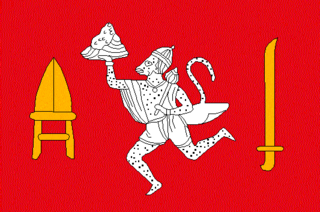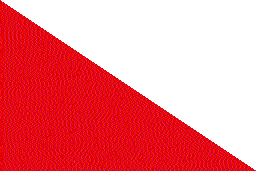
The Central India Agency was created in 1854, by amalgamating the Western Malwa Agency with other smaller political offices which formerly reported to the Governor-General of India. The agency was overseen by a political agent who maintained relations of the Government of India with the princely states and influence over them on behalf of the Governor-General. The headquarters of the agent were at Indore.

The Holkars were a powerful family that was part of the Maratha Confederacy, which held the rank of subahdar under Peshwa Baji Rao I. When the Maratha Empire began to weaken due to internal clashes, the Holkars declared themselves rulers of the Indore in Central India, which existed as an independent member of the Maratha Empire until 1818. Later, their kingdom became a princely state under the protectorate of British India.

Marwar is a region of western Rajasthan state in North Western India. It lies partly in the Thar Desert. The word 'maru' is Sanskrit for desert. In Rajasthani languages, "wad" means a particular area. English translation of the word 'marwar' is 'the region of desert.'
Parmar, also known as Panwar, Pawar, Powar or Bhoyar is a Rajput clan found in Northern and Central India, especially in Rajasthan, Gujarat, Punjab, Haryana, Uttarakhand, Himachal Pradesh, Madhya Pradesh, Uttar Pradesh, Bihar, Chattisgarh, Kutch, Sindh and North Maharashtra. The clan name is also used by Koli people.

The Rathore or Rathor is an Indian Rajput dynasty belonging to the clan that has historically ruled over parts of Rajasthan, Gujarat, Madhya Pradesh and Uttar Pradesh.

Bhopawar Agency was a sub-agency of the Central India Agency in British India with the headquarters at the town of Bhopawar, so the name. Bhopawar Agency was created in 1882 from a number of princely states in the Western Nimar and Southern Malwa regions of Central India belonging to the former Bhil Agency and Bhil Sub-agency with the capitals at Bhopawar and Manpur. The agency was named after Bhopawar, a village in Sardarpur tehsil, Dhar District of present-day Madhya Pradesh state. Manpur remained a strictly British territory.

Gwalior state was a semi-autonomous Maratha state. It was centred in modern-day Madhya Pradesh, arising due to the rise of the Maratha Empire and fragmentation of the Mughal Empire.
Badnawar (or Badnavar) is a Town, former pargana and a Nagar Parishad of the Dhar district in the state of Madhya Pradesh, India. This is a tehsil place having 170 villages. Badnawar is around 95 km from Indore - the business capital of Madhya Pradesh.
Betma is a town and a nagar panchayat in Indore district in the state of Madhya Pradesh, India.

Kingdom of Marwar, also known as the Jodhpur State under the British, was a kingdom in the Marwar region from 1243 to 1818 and a princely state under British rule from 1818 to 1947. It was established in Pali by Rao Siha, possibly a migrant Gahadavala noble, in 1243. His successors continued to struggle against regional powers for domination and 9 out of 15 rulers till 1438 died in combat. In 1395, its capital was changed to Mandore by Rao Chunda and to Jodhpur in 1459 by Rao Jodha.

The Paramara Dynasty was an Indian dynasty that ruled Malwa and surrounding areas in west-central India between 9th and 14th centuries. They belonged to the Parmara clan of the Rajputs.
The Rahevar are a clan found in the state of Gujarat in India.

Narsinghgarh State is a former princely state of the British Raj in India. It formed an enclave within Rajgarh State and was placed administratively under the Bhopal Agency subdivision of the Central India Agency. The state covered an area of 1,920 square kilometres (740 sq mi) and had a population of 92,093 and an average revenue of Rs.5,00,000 in 1901.

Ratlam State was a 13 gun salute princely state in India, part of the Malwa Agency of Central India during the British Raj.

Sailana State was an 11 gun salute princely state in India, part of the Malwa Agency of Central India during the British Raj. The state enjoyed an estimated revenue of Rs.5,00,000.

Rajgarh State was a princely state in India, named after its capital Rajgarh, Madhya Pradesh. It was part of the colonial Bhopal Agency of the Central India Agency during the British Raj. It lay in the region of Malwa known as Umatwara after the ruling Umat clan, a branch of the Parmar Rajputs. The neighbouring Narsinghgarh State was ruled by a cadet branch of this family, after being partitioned in 1681.
Kampel is a panchayat village in the Indore block of the Indore district, Madhya Pradesh, India. It was the headquarters of a pargana in Mughal Empire before the administrative center of the region was shifted to Indore city under the Holkars of the Maratha Empire.

Rao Nandlal Chaudhary was the chief of the Zamindars of Kampel, near Indore. He was a Gaur Brahmin. Under the suzerainty of the Mughals, he controlled Kampel and some of its surrounding area including Indore. He accepted the suzerainty of the Marathas, after the Nizam acceded to the Peshwa's demands in 1724.

Raghogarh State, also known as Raghugarh and as Khichiwara, was a princely state of the Gwalior Residency, under the Central India Agency of the British Raj. It was a Thikana state of about 109 km2 with a population of 19,446 inhabitants in 1901. The Parbati River marked the western border of the state. The capital was at Raghogarh in present-day Guna district of Madhya Pradesh.
The Rajputs in Gujarat are members of the Rajput community living in the western Indian state of Gujarat. They ruled several dynasties and princely states during the British era. Some Rajput clans of Gujarat have origins from outside regions such as Rajasthan, while others are native to the region.














